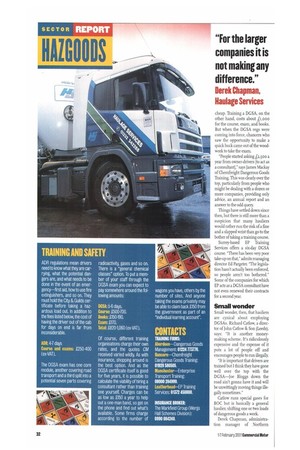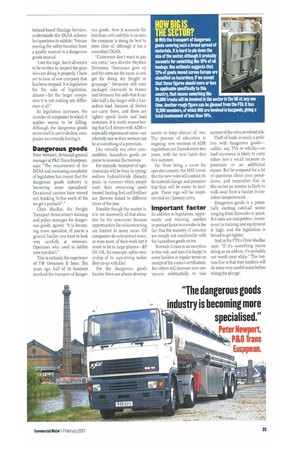"For the larger companies it is not making any difference."
Page 134

Page 135

If you've noticed an error in this article please click here to report it so we can fix it.
Derek Chapman, Haulage Services
cheap. Training a DGSA, on the other hand, costs about £1,0 00 for the course, exam, and books. But when the DG SA regs were coming into force, chancers who saw the opportunity to make a quick buck came out of the woodwork to take the exam.
"People started asking £2,500 a year from owner-drivers to act as a consultant]," says James Mackay of Chernfreight Dangerous Goods Training. This was clearly over the top, particularly from people who might be dealing with a dozen or more companies, providing only advice, an annual report and an answer to the odd query.
Things have settled down since then, but there is still more than a suspicion that many hauliers would rather run the risk of a fine and a slapped wrist than go to the bother of taking a training course.
Surrey-based EP Training Services offers a six-day DGSA course. "There has been very poor take-up on that," admits managing director Ed Pargeter. "The legislation hasn't actually been enforced, so people aren't too bothered." Some of the companies for which EP acts as a DGSA consultant have not even renewed their contracts for a second year.
Small wonder
Small wonder, then, that hauliers are cynical about employing DGSAs. Richard Catlow, a director of John Catlow 8, Son (Leeds), says; "It is another moneymaking scheme. It's ridiculously expensive and the expense of it puts a lot of people off and encourages people to tun illegally.
"It is important that drivers are trained but I think they have gone well over the top with the DGSA—Joe Bloggs down the road ain't gonna have it and will be unwittingly moving things illegally sometimes."
Catlow runs special gases for BOC but is basically a general haulier, shifting one or two loads of dangerous goods a week.
Derek Chapman, administration manager of Northern Ireland-based Haulage Services, understands the DGSA scheme but questions its validity: You are moving the safety function from a quality manual to a dangerous goods manual.
"I see the logic, but it all seems to be written to inspect the guys who are doing it properly. I have yet to hear of one company that has been stopped. It is legislation for the sake of legislation, almost—for the larger companies it is not making any difference at all."
As legislation increases, the number of companies to which it applies seems to be falling. Although the dangerous goods sector itself is not in decline, companies are certainly leaving it.
Dangerous goods
Peter Newport, divisional general manager at P&O Trans European, says: "The requirement of the DGSA and increasing complexity of legislation has meant that the dangerous goods industry is becoming more specialised. Occasional carriers have moved out, thinking `Is this worth it? Do we get a payback?'."
Chris MacRae, the Freight Transport Association's training and policy manager for dangerous goods, agrees: "It is becoming more specialist. If you're a general haulier you have to look very carefully at revenues. Operators who used to dabble now just don't."
This is certainly the experience of TW Devanney 8c Sons. Ten years ago, half of its business involved the transport of danger
ous goods. Now it accounts for less than ro% and this is an area the company is doing its best to steer clear of, although it has a consultant DGSA.
"Customers don't want to pay any extra," says director Stephen Devanney. "Insurance goes up and the rates are the same as you get for doing dry freight or groupage." Devanney still runs packaged chemicals to France and Germany but adds that it can take half a day longer with a hazardous load, because all ferries can carry them, and there are tighter speed limits and load restraints. It is worth remembering that C+E drivers with ADRespecially experienced ones—are relatively rare so their services can be at something of a premium.
Like virtually any other commodities, hazardous goods are prone to seasonal fluctuations.
For example, transport of agrichemicals will be busy in spring; sodium hydrochloride (bleach) peaks in summer when people want their swimming pools treated; heating fuel and fertiliser are likewise linked to different times of the year.
Sizeable though the market is, it is not necessarily all that attractive for the newcomer because opportunities for subcontracting are limited in many areas. Oil companies do subcontract some, or even most, of their work but it tends to be to large players—BP Oil UK, for example, splits ownership of its 240-strong tanker fleet 50-5o with Exel.
For the dangerous goods haulier there are always develop
ments to keep abreast of, too. The process of education is ongoing: new versions of ADR regulations are framed every two years, with the next batch due this summer.
Far from being a cause for operator concern, the H SE insists that the new rules will contain little material change, and promises that they will be easier to navigate. These regs will be implemented on I January 2003.
Important factor
In addition to legislation, opportunity and training, another important factor to consider is the fact that the majority of insurers are simply not comfortable with the hazardous goods sector.
Norwich Union is an exception to this rule, and says it is happy to cover hauliers at regular terms on receipt of the correct certification. But others will increase your premiums substantially to take account of the extra perceived risk.
Theft of loads is rarely a problem with dangerous goods— unlike, say, TVs or whisky—so load insurance is likely to carry either just a small increase in premium or an additional excess. But be prepared for a lot of questions about your procedures, and remember that in this sector an insurer is likely to walk away from a haulier it considers inexperienced.
Dangerous goods is a potentially exciting catch-all sector ranging from fireworks to paint. But rates are competitive, investment in training and equipment is high, and the legislation is bound to get tighter.
And as the ETA's Chris MacRae says: "If it's something you're doing as an add-on, it's probably not worth your while." The bottom line is that wise hauliers will do some very careful sums before taking the plunge.




































































































































































































